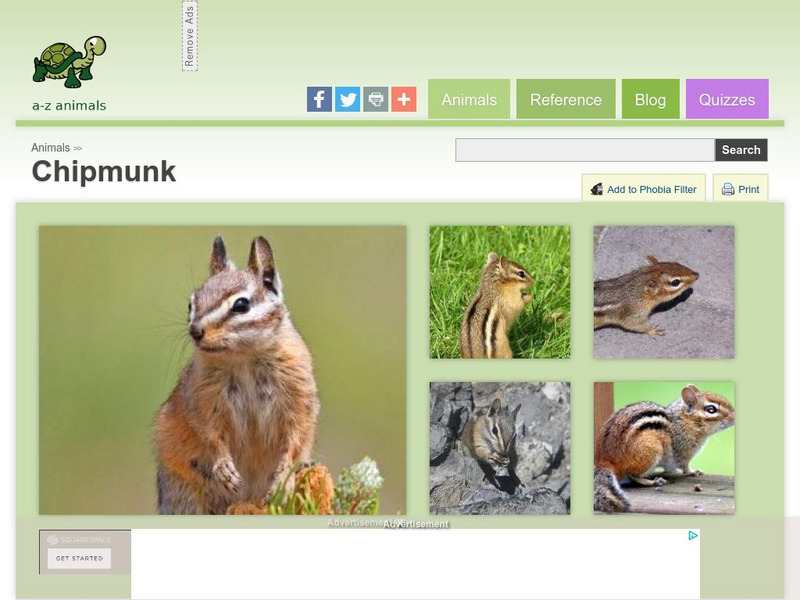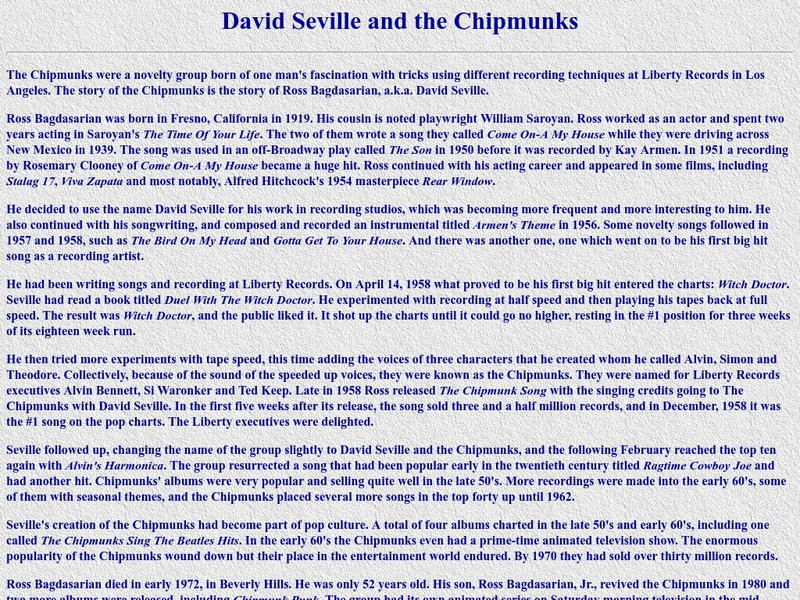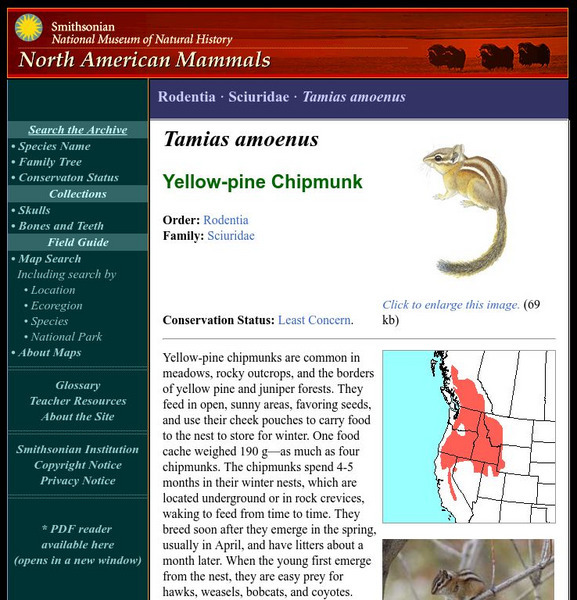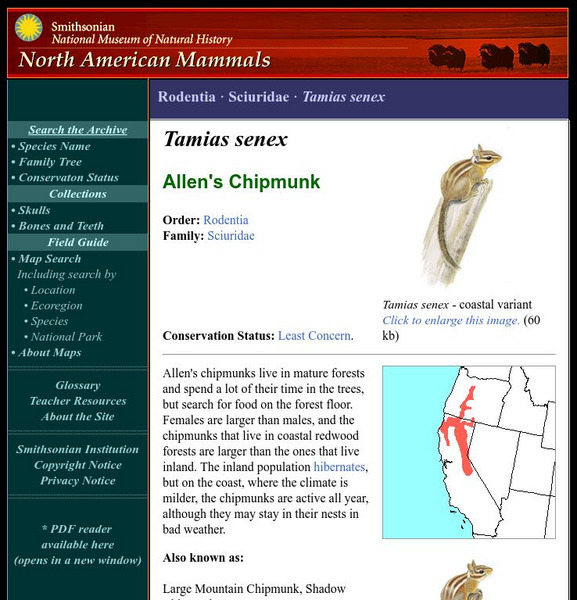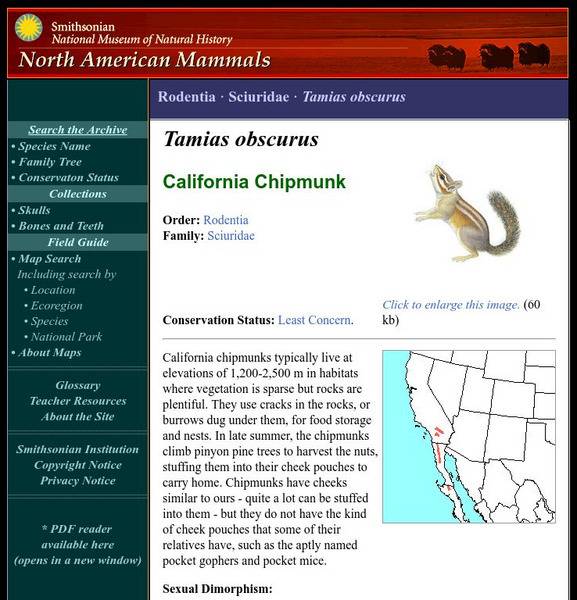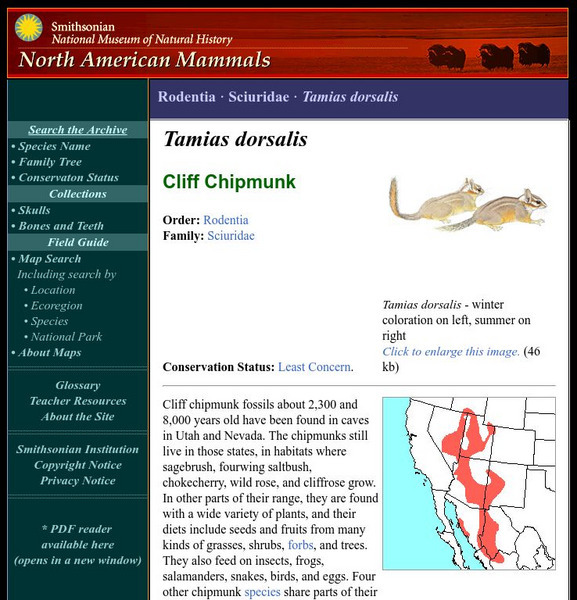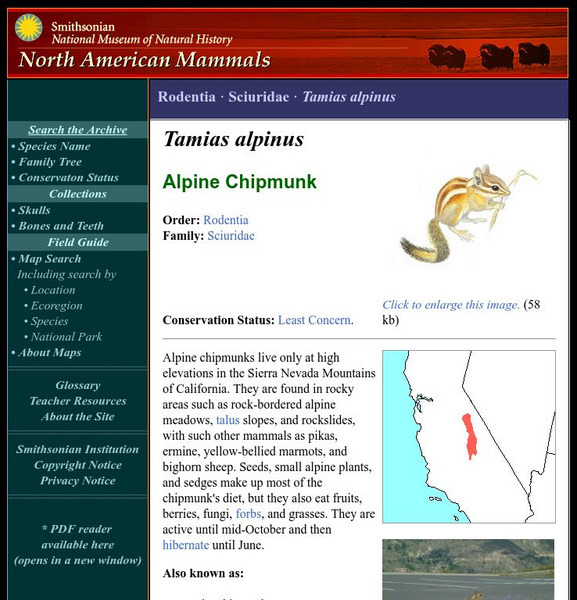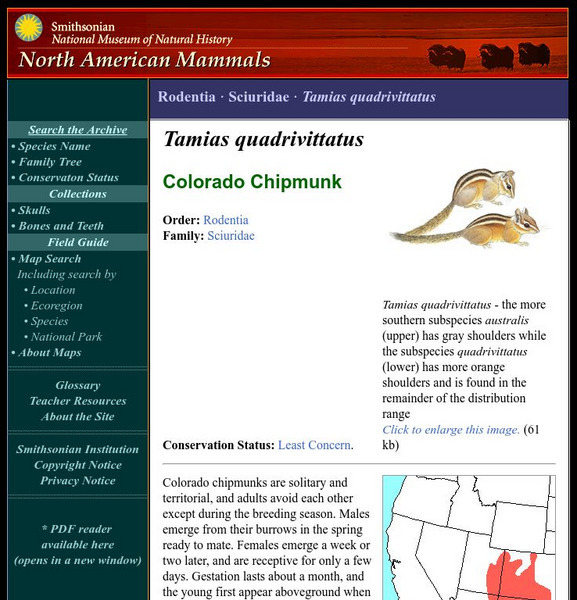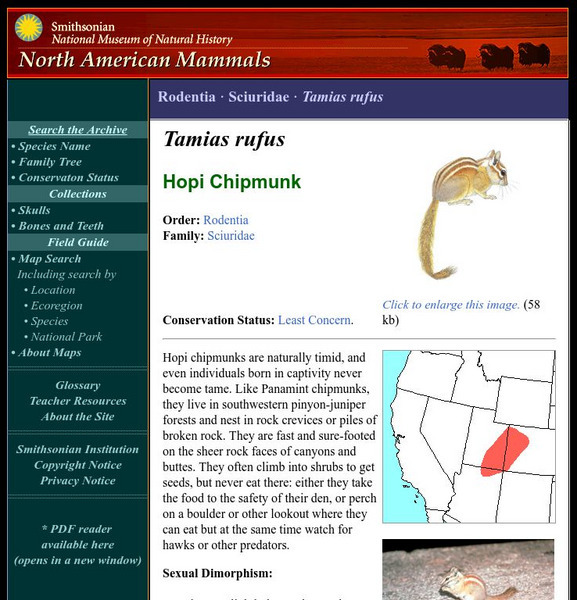PBS
Nh Pbs: Nature Works: Eastern Chipmunk
Did you know the Eastern Chipmunk has white fur on its stomach and reddish-brown fur on its back? Come and explore this educational resource to learn more about this creature's diet, habitat, life cycle and more.
Canadian Wildlife Federation
Hinterland Who's Who: Chipmunks
Canadian Wildlife site features the Chipmunk. Highlights its habitats and habits, range, feeding and breeding characteristics.
A-Z Animals
A Z Animals: Animal Facts: Chipmunk (Tamias Striatus)
View images and learn facts about Chipmunks, including where they live, their appearance, diet, and how they disguise themselves from predators.
Royal Canadian Geographical Society
Canadian Geographic: Animal Facts: Eastern Chipmunk
Learn fast facts, the physiology, habitats, behaviors and range of the Eastern chipmunk.
Other
Personal Site: David Seville and the Chipmunks
This personal site provides information on the creator of Dave Seville and the Chipmunks, Ross Bagdasarian, and how he started The Chipmunks.
Canadian Museum of Nature
Canadian Museum of Nature: Eastern Chipmunk
Eastern chipmunks can be found in North American forests in eastern Canada. They are popular for their friendly interactions with humans. Details about their habits and diet are given here.
Smithsonian Institution
National Museum of Natural History: American Mammals: Yellow Pine Chipmunk
Yellow-pine chipmunks are common in meadows, rocky outcrops, and the borders of yellow pine and juniper forests. They feed in open, sunny areas, favoring seeds, and use their cheek pouches to carry food to the nest to store for winter....
Smithsonian Institution
National Museum of Natural History: American Mammals: Allen's Chipmunk
Allen's chipmunks live in mature forests and spend a lot of their time in the trees, but search for food on the forest floor. Females are larger than males, and the chipmunks that live in coastal redwood forests are larger than the ones...
Smithsonian Institution
National Museum of Natural History: American Mammals: California Chipmunk
California chipmunks typically live at elevations of 1,200-2,500 m in habitats where vegetation is sparse but rocks are plentiful. They use cracks in the rocks, or burrows dug under them, for food storage and nests. Learn more about the...
Smithsonian Institution
National Museum of Natural History: American Mammals: Cliff Chipmunk
Cliff chipmunk fossils about 2,300 and 8,000 years old have been found in caves in Utah and Nevada. The chipmunks still live in those states, in habitats where sagebrush, fourwing saltbush, chokecherry, wild rose, and cliffrose grow....
Smithsonian Institution
National Museum of Natural History: American Mammals: Alpine Chipmunk
Alpine chipmunks live only at high elevations in the Sierra Nevada Mountains of California. They are found in rocky areas such as rock-bordered alpine meadows, talus slopes, and rockslides, with such other mammals as pikas, ermine,...
Smithsonian Institution
National Museum of Natural History: American Mammals: Colorado Chipmunk
Colorado chipmunks are solitary and territorial, and adults avoid each other except during the breeding season. Males emerge from their burrows in the spring ready to mate. Learn more about the Tamias quadrivittatus, more commonly known...
Smithsonian Institution
National Museum of Natural History: American Mammals: Merriam's Chipmunk
Merriam's chipmunk's calls are distinctive. Perched on top of a stump or rock, the chipmunks vocalize long and vigorously, and the "chip" sound is often followed by a burst of sound called a "terminal pulse. Learn more about the Tamias...
Smithsonian Institution
National Museum of Natural History: American Mammals: Yellow Cheeked Chipmunk
Yellow-tailed chipmunks are common in California's dark, moist giant redwood forests. These relatively large chipmunks are hard to see but they can be recognized by a unique call given when intruders are present. Learn more about the...
Smithsonian Institution
National Museum of Natural History: American Mammals: Palmer's Chipmunk
Palmer's chipmunks live in a "sky island" mountains in southwestern Nevada surrounded by deserts the chipmunks cannot cross. They are common there, foraging where rocks or fallen logs provide cover. Learn more about the Tamias palmeri,...
Smithsonian Institution
National Museum of Natural History: American Mammals: Red Tailed Chipmunk
Red-tailed chipmunks sandbathe to clean their fur, rolling and rubbing, sometimes half-buried in sand. They are rarely seen outside their burrows on cold winter days, but in the spring they are out and about, eating seedlings, leaves,...
Smithsonian Institution
National Museum of Natural History: American Mammals: Panamint Chipmunk
Panamint chipmunks are named for the mountains in the Southwest where they were first collected by scientists, in 1890. As with many chipmunks, males and females look alike and are the same size. Learn more about the Tamias panamintinus,...
Smithsonian Institution
National Museum of Natural History: American Mammals: Siskiyou Chipmunk
Siskiyou chipmunks have their own, distinct vocalization: a long, intense, one-syllable call that starts low, rises, and then falls again. It starts at a frequency of about 300 kHz, rises to more than 1,600 kHz, then falls to about 400...
Smithsonian Institution
National Museum of Natural History: American Mammals: Sonoma Chipmunk
Young male Sonoma chipmunks disperse from the nest after weaning, but females remain near where they were born. From December through June, males travel extensively, seeking mates and competing with other males. Learn more about the...
Smithsonian Institution
National Museum of Natural History: American Mammals: Townsend's Chipmunk
Clear-cut logging, which destroys habitat for some animals, offers good living conditions for Townsend's chipmunks. They find denning sites, cover, and food among the fallen, decaying logs and sprouting evergreens. Learn more about the...
Smithsonian Institution
National Museum of Natural History: American Mammals: Uinta Chipmunk
Uinta chipmunks are common in coniferous forests, especially at elevations higher than 1,800 m. They readily climb trees and shrubs to forage for seeds and often sleep in trees. Learn more about the Tamias umbrinus, more commonly known...
Smithsonian Institution
National Museum of Natural History: American Mammals: Hopi Chipmunk
Hopi chipmunks are naturally timid, and even individuals born in captivity never become tame. Like Panamint chipmunks, they live in southwestern pinyon-juniper forests and nest in rock crevices or piles of broken rock. Learn more about...
Smithsonian Institution
National Museum of Natural History: American Mammals: Least Chipmunk
The least chipmunk is the smallest and most widely distributed North American chipmunk. It occurs in a variety of habitats, from coniferous forests to meadows to sagebrush desert, feeding primarily on seeds but also eating flowers, buds,...
Smithsonian Institution
National Museum of Natural History: American Mammals: Lodgepole Chipmunk
The range of the Lodgepole Chipmunk follows the high Sierra Nevada, and continues along the tops of the San Bernardino and San Jacinto mountains near Los Angeles. Most of the time the Lodgepole Chipmunks forage on the ground, climbing on...




